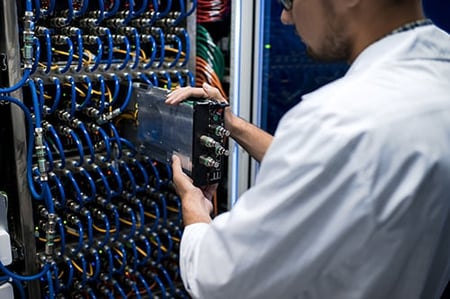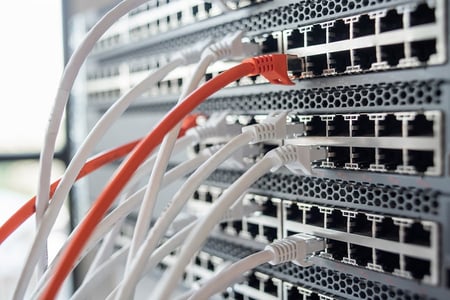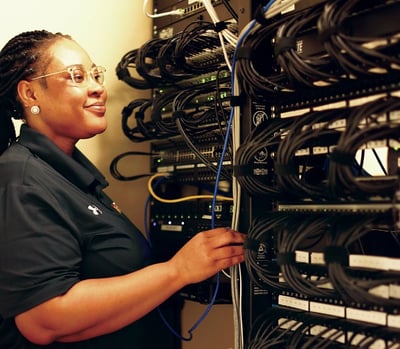IT INFRASTRUCTURE
TABLE OF CONTENTS
IT Infrastructure
The IT infrastructure comprises both tangible and intangible elements that facilitate users' activities and services to accomplish business functions. It encompasses various components such as software applications, application-hosting servers, data centers to house these servers, and network infrastructure that enables access to business applications and servers.
What is the Role of IT Infrastructure Management?
IT infrastructure management addresses the essential elements required to deliver business services, with a primary focus on both software and physical network devices. These components play a vital role in the effective management of IT infrastructure to support the delivery of various business services.
What are the Components of IT Infrastructure Management?
IT infrastructure managers have the responsibility of overseeing the entire lifecycle of various components, including:
- Computer Hardware Platforms – This encompasses laptops, desktop PCs, servers, and mainframes.
- Software Applications – They oversee supervising critical enterprise software such as Microsoft, SAP, and Oracle.
- Operating Systems – This involves managing operating systems like Windows, Mac OS, Linux, and UNIX that run on computer hardware.
- Data Management and Storage – They oversee the physical components of data storage, such as servers, as well as the software used to organize databases, like Oracle, MySQL, and IBM.
- Networking and Telecommunications – This includes the internal network, which involves virtual network software like Microsoft Windows server and Cisco, physical telecommunications infrastructure like telephones and routers, and internet infrastructure like websites hosted on internal or external servers, as well as web software development tools.
Benefits of IT Infrastructure Management
The benefits of IT infrastructure management encompass:
- Increases in response time to disruptions and operations changes
- Automation to drive cost reductions
- Efficiencies in employee operations
- System downtime reduction
Do I need Computer Management Support for Infrastructure?
How do you handle the situation when your computers go down? Here are some common approaches:
- I attempt to resolve the issue myself, which can divert my attention from my primary job tasks.
- I maintain an expensive IT team on staff to address any problems that arise.
- I search online for a technical support provider as needed.
While these responses are often encountered, they may not be the most efficient choices for your business.
Employing a dedicated IT support staff can strain your company's budget, especially if they spend significant time idle while waiting for issues to occur. Additionally, relying on one or two IT professionals may not be sufficient to handle multiple problems simultaneously, leaving them overwhelmed.
An alternative solution is to opt for professional computer technical support services. With this approach, you only pay for the specific services you require, avoiding the burden of a yearly salary for an entire IT staff. Moreover, you don't have to search for help when issues arise, as you'll have a reliable computer technical support team available to assist you on-site, over the phone, or online. By using customer technical support services, you ensure that your problems are promptly resolved, without disrupting your regular responsibilities. This streamlined and cost-effective approach to technical support can greatly benefit your business.
What is Network Management?
Network management encompasses a comprehensive range of applications, equipment, and procedures employed in the setup, operation, administration, maintenance, and security of the network infrastructure. Its primary purpose is to empower administrators with the ability to effectively oversee and monitor the network, ensuring its reliability, availability, and performance. Moreover, network management enables quick configuration adjustments to address issues promptly and optimize overall network performance.
To achieve these goals, network administrators employ well-defined processes or workflows to properly supervise the network. Due to the continuous introduction of new technologies and connections, these workflows are subject to ongoing evolution. Therefore, it is vital for administrators to maintain an up-to-date inventory of all network devices, establish a protocol to evaluate their efficiency, and effectively manage their lifecycle.
This emphasis on maintaining an accurate inventory and monitoring the lifecycle of devices is of utmost importance, as outdated or inadequately maintained devices can present unnecessary security risks.

Do I need Network Management?
Network management is crucial because it brings together a wide range of components, varying from just a few to several thousand that interact with each other. Its purpose is to safeguard against malfunctions, misconfigurations, and failures by facilitating the rapid identification and deployment of tools necessary to address these issues. The primary goal of network management is to ensure the network functions as intended to achieve key business objectives:
What is Network Infrastructure?
The term "infrastructure" was originally coined to describe the layout and planning of railroads in France during the late 19th century. Over time, its scope expanded to encompass all essential foundational structures such as roads, utilities, and telecommunications that are crucial for the proper functioning of society.
In today's modern enterprises, the concept of "network infrastructure" carries a similar meaning, referring to the technological framework that supports day-to-day operations. This infrastructure includes a wide range of elements, from desktop computers and handheld smart devices to various apps, software, and networks. Essentially, a company's network infrastructure serves as both its backbone and central nervous system, enabling it to securely and efficiently gather, share, and store data.
As technology continues to advance, network infrastructure faces increasing demands. This includes the integration of new smart devices, apps for field service personnel, and the adoption of cloud-based platforms for data storage. Regardless of where a business stands on its technical journey, challenges with network infrastructure setup are inevitable.
To streamline operations and ensure smooth functioning, organizations must be prepared to make informed decisions regarding technology adoption. They need to maintain responsive and diligent network infrastructure management from their IT teams or Managed IT partners. By doing so, businesses can protect themselves from the latest technical difficulties and cyber threats, allowing their operations to continue uninterrupted.

Types of Networks
Computer networks come in various sizes, ranging from simple and small setups to incredibly vast and intricate systems, depending on the number of connected people or devices. For example, small organizations may only have a few devices interconnected within the same office, whereas global enterprises might have hundreds or even thousands of devices spread across the world.
The selection of network types depends on the specific requirements for secure and efficient communication among these devices. Some common network types include:
- LAN or Local Area Network which connects devices within a confined local environment. It is often chosen to interconnect all the computers used by employees within a small office.
- WLAN or Wireless Local Area Network is similar to LAN, this network also connects devices within a local area but utilizes wireless connections, enabling employees to use wireless devices and enhancing mobility.
- VPN or Virtual Private Network is a secure network that allows users to send encrypted data. VPNs are an excellent choice for remote employees, as they provide the same level of security as office employees experience within their local network.
- WAN or Wide Area Network facilitates the connection of devices across long distances, making it suitable for large enterprise networks that span vast geographical areas.
Why do You need IT Network Support Services?
When faced with an IT network problem that your staff cannot resolve, what course of action should you take? The consequences of unplanned downtime are well-known, as every minute of it can result in significant financial losses for your business. Just envision the profit impact a retailer might face if a major computer glitch occurs during the holiday shopping season.
Now, consider how you would handle the following situations:
- It's 3:00 a.m. on a Wednesday, and one of your servers experiences catastrophic failure.
- Severe weather is approaching, and your company's sole data backup is stored on-site.
- Your network goes down, disrupting remote employees' connectivity and productivity while you troubleshoot the issue.
- You fall victim to ransomware, and you're uncertain when the last data backup was completed.
In such critical scenarios, relying solely on a reactive IT strategy is insufficient. If the thought of encountering any of these challenges during your peak business season leaves you anxious, it's time to explore an IT Services solution that offers complete peace of mind.
To stay ahead of issues like equipment failure, software updates, data backups, infrastructure expansion, and cybersecurity disasters, you need dedication, talent, and round-the-clock support. Some companies choose to hire full-time, in-house IT staff to address these needs, but this approach can be costly and might lack expertise in handling every possible situation.
This is why many companies opt for a managed IT support partner that provides live 24/7 support and significant cost savings compared to maintaining an in-house IT team. With the right managed IT support, you can focus on your core business while ensuring your IT infrastructure remains reliable and secure, regardless of the challenges that may arise.
What does Network Management Encompass?
Network management encompasses a series of critical activities that are essential for maintaining the operational efficiency and security of network systems:
Involves the setup of network software, operating systems, and management tools required for network operation. This includes adding and keeping track of network resources such as computers, servers, cables, routers, switches, hubs, etc. Additionally, network administrators handle software updates and continuously monitor network performance.
Focuses on ensuring the network operates smoothly and as intended. To achieve this, the network activity is closely monitored to identify and address problems proactively.
What are Network Security Services?
The surge in hacking, malware, and cybercrime has reached alarming levels, with global damages from cybercrime reaching a staggering $6 trillion in 2021. Experts predict that this figure will escalate to a shocking $10.5 trillion annually by 2025, making it the largest transfer of wealth in economic history.
If you are reading this, you are likely concerned about your organization's network security. Taking this concern seriously is a crucial first step, but the overwhelming statistics demand proactive measures - and that's where preparedness comes into play.
The FBI, being at the forefront of investigating cybercrimes against American individuals, companies,
and the nation, has noticed a concerning shift in cybercriminal tactics. Formerly, malicious software aimed at holding personal or business data hostage for ransom, but now they have evolved into more severe and targeted attacks. These sophisticated threats seek to steal and exploit intellectual property and sensitive information.
Even small businesses in manufacturing, biotech, logistics, and other sectors are no longer immune to cyberattacks. The dark web acts as a convenient marketplace for selling illicitly obtained data, making it imperative for businesses to adopt stringent network security measures that are vigilant, continuous, and regularly evaluated for their effectiveness.
What are the Challenges of Network Management?
Attempting to handle your network independently or with a small in-house IT team presents numerous challenges, ranging from complexity and cost to cybersecurity concerns:
- Complexity—Regardless of the organization's size, managing network infrastructure is a highly intricate task due to various factors. These include the sheer volume and diversity of network devices and operating systems, security requirements, user accessibility (both local and remote), and data storage locations (local, off-site, or cloud-based). Given the need for hundreds or thousands of devices and systems to work seamlessly together, those responsible for network maintenance must possess an extensive knowledge base to tackle any issues that may arise.
- Cost—Efficiently managing network infrastructure incurs expenses in terms of both technology and the required labor to ensure its smooth operation. As an organization grows and its network needs to scale, costs often increase, sometimes exponentially. When considering network maintenance, it is essential to carefully evaluate the option of partnering with Managed IT service providers, which can prove to be more cost-effective than maintaining an in-house IT team.
- Security Threats—Network management demands continuous vigilance and strategic planning to safeguard systems from the ever-growing range of security threats that can be just a single click away. Networks of all sizes must be diligently protected against vulnerabilities and potential points of failure that could disrupt operations across the entire organization.
- Manage User Expectations—User productivity heavily relies on the speed of devices and network connectivity. This is particularly critical for remote workers, where network bandwidth plays a crucial role in sustaining peak performance. Slow or unreliable infrastructure can lead to reduced productivity and ultimately diminish returns on the organization's overall investment.
Network Management Best Practices
To build an optimal environment for effective network management, certain best practices must be considered. Given the ever-changing nature of technology, it is essential to continuously update your network with the latest technology and processes. Network management administrators need to remain up-to-date with these changes to ensure the network operates smoothly and securely.
Here are some key best practices to consider:
- Network Topology—Maintaining an accurate and up-to-date topology of your network layout is crucial for preventing security vulnerabilities. While it may seem challenging to keep track of, having a clear understanding of the network's structure is essential for effective management.
- Network Management Protocols—Properly documenting network management protocols is essential. This documentation allows administrators to identify and plan for various scenarios, enabling them to avoid errors during emergencies and respond effectively to network performance issues and system downtime.
- Budgeting Projected Need—Expanding the network to accommodate new users requires careful planning for success. This process involves conducting a comprehensive assessment of the current network and then projecting future needs based on growth predictions. This projection will be instrumental in estimating future IT expenses accurately.
What is Network Topology?
In network management, "topology" refers to the organizational structure of a network. It can be visualized as a comprehensive map outlining all the devices within the network and their precise interconnections. Essentially, it provides clear descriptions of the spatial relationships among these devices. To maintain an efficient and well-functioning network, the topology must be regularly updated in a proactive manner whenever any changes or additions are implemented in any section of the network.
Network Devices
A network consists of a diverse range of devices beyond the familiar workstations and mobile devices used daily. Here are some other essential components found within a network:
What are IT Server Management Services?
IT server management services provide comprehensive support for effectively managing and maintaining your server, ensuring its continuous and optimal performance. The range of services includes:
- Initial setup and configuration of both the server hardware and the software it runs on.
- Regular updates and maintenance of the server's software and operating system as needed.
- Continuous monitoring of the server and all processes running on it to detect and address any potential issues proactively.
- Ensuring the server operates optimally to prevent any disruptions to regular functioning.
- Resolving any other server management challenges that may arise over time.
Why do I need Server Management Support?
Whether you're a sole proprietor or a sizable corporation, server management is essential for every organization that operates a server. While you could opt to handle server management internally, it begs the question - why would you? Server management is not your core business, making it more sensible to entrust this responsibility to skilled professionals. Hiring expert server managers increases the likelihood of swiftly and accurately resolving any server-related challenges that may arise. Doesn't it sound more appealing than having to invest your valuable time in maintaining and troubleshooting servers on your own?

PCS is Your Source for Infrastructure, Network, and Server Management Solutions
In the fiercely competitive business landscape of today, a single unexpected network failure can lead to prolonged downtime and deliver a heavy financial blow to your company. If you rely solely on in-house IT staff, you may face limitations when network troubles strike. Perhaps you often wish for a simpler, friendlier, and more cost-effective approach to accessing managed network services.
Well, the good news is that PCS has eradicated the hassles and worries associated with IT infrastructure support. As a leading managed network services provider, we prioritize your company's needs, always maintaining a human touch. Our aim is to never talk down to you or overwhelm you with confusing techno-jargon.
When you choose PCS for your network management services, you benefit from the following:
- A Virtual CIO (Chief Information Officer)
- Access to our team of highly trained IT professionals
- Live customer service representatives available on our call line
- A commitment to communicate with you in plain, straightforward language, ensuring you feel respected and well-informed
Moreover, with PCS managing your network, you can rest easy knowing that your business will experience reduced downtime. In the rare event that an issue does arise, you will have access to the right expertise to quickly resolve the situation. This leads to enhanced continuity and productivity for your business and significantly less worry for you. Contact us for a free 30-minute IT consultation.

